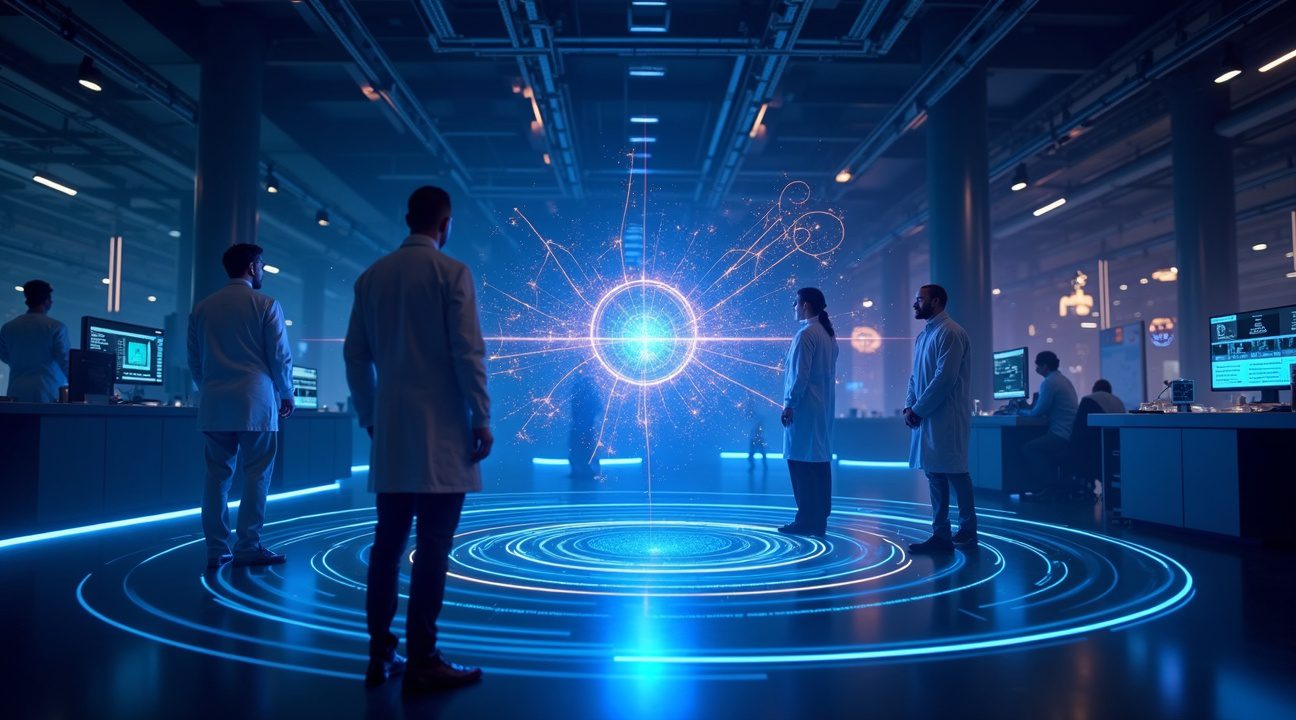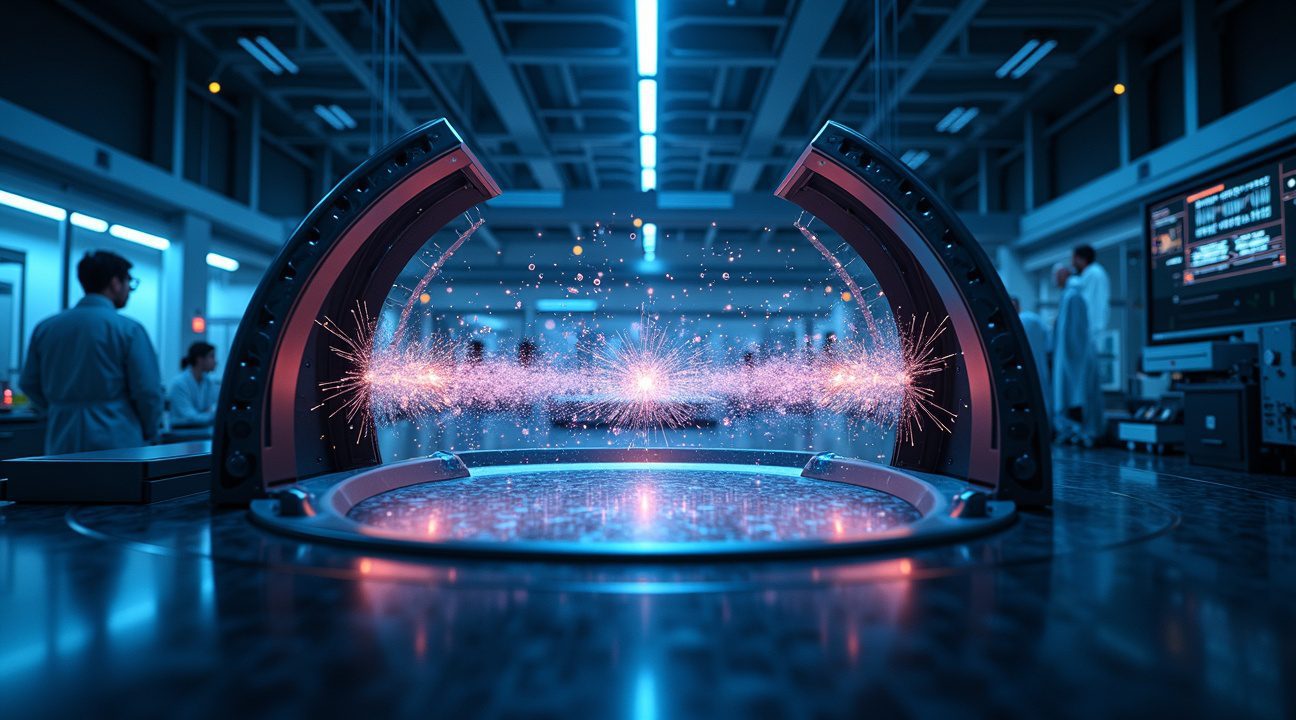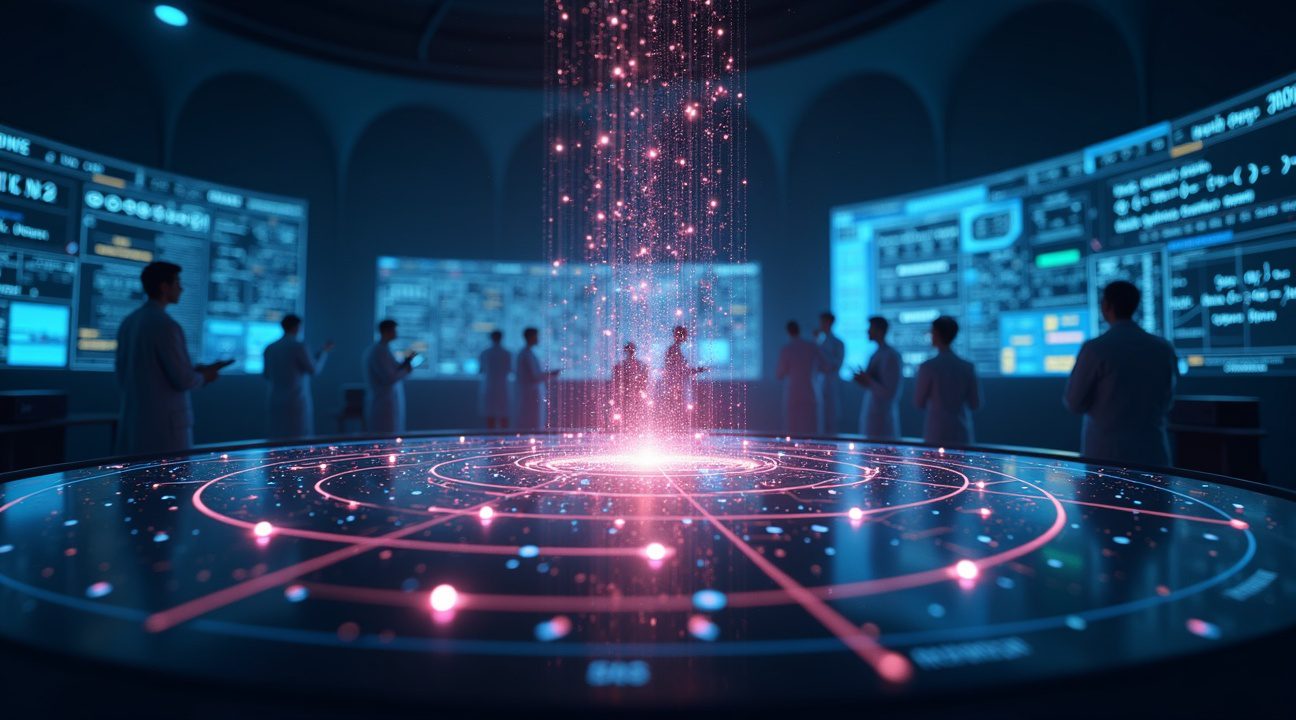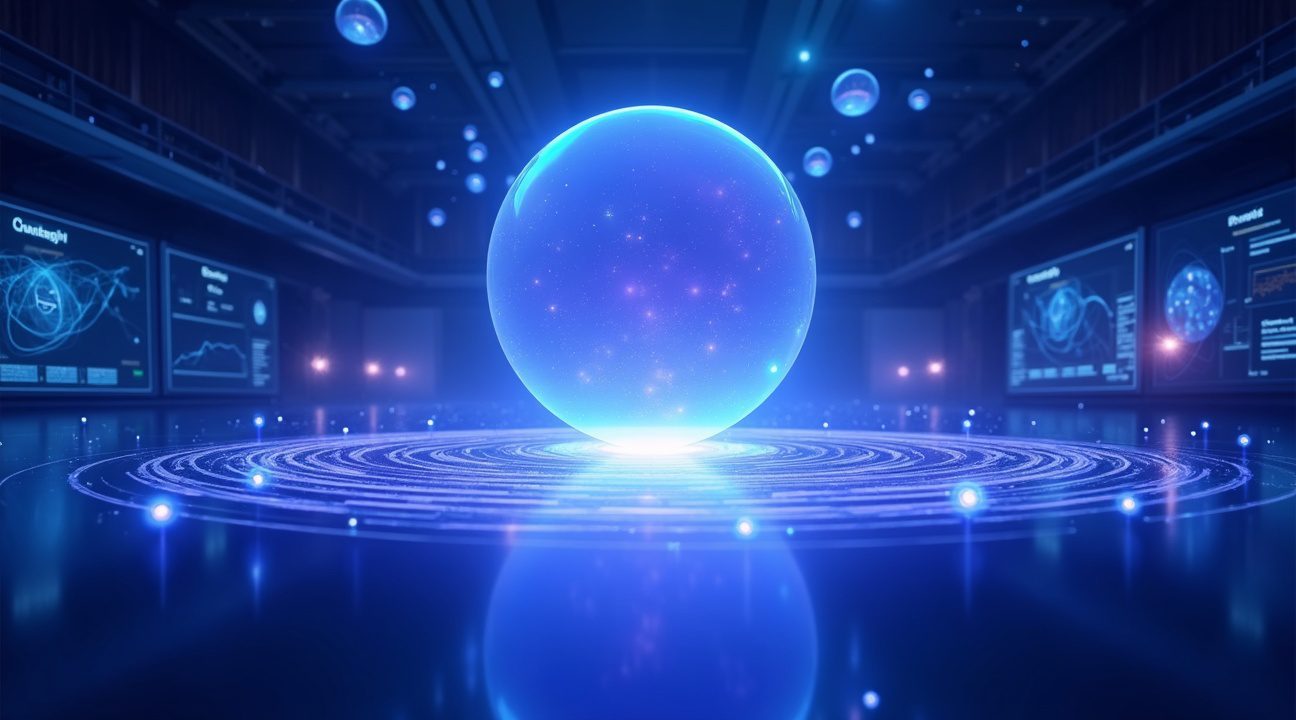Revolutionary Quantum Timekeeping Breakthrough by MIT and Harvard Physicists
MIT and Harvard physicists have achieved a revolutionary advancement in quantum timekeeping by developing a radical new method that defies traditional clock-based systems, offering accuracy 100,000 times greater than current standards through quantum entanglement.
Their pioneering technique, called quantum-amplified global-phase spectroscopy—also referred to as quantum GPS—utilizes entangled atoms to surpass the standard quantum limit in precision timing. This new method could revolutionize fields from fundamental physics to navigation technologies.
Key Takeaways
- Quantum entanglement between atoms like ytterbium dramatically increases timing precision by reducing measurement uncertainty via synchronized atomic networks.
- No traditional starting point is needed for time measurements, thanks to wave-based properties of Rydberg atoms and sophisticated pump-probe laser techniques.
- Applications extend beyond laboratories, including dark matter detection, earthquake prediction through gravitational anomaly detection, and next-generation GPS systems.
- W state configurations involving three entangled photons allow quantum synchronization even after individual particles are measured.
- Government backing from agencies like DARPA, NSF, and the Department of Energy highlights the strategic national importance of quantum timing research.
Technology Behind the Discovery
This innovation redefines how scientists measure time at its most fundamental level. By utilizing the principles of quantum mechanics at the atomic scale, researchers have constructed a system that eliminates traditional clock limitations.
Quantum entanglement creates a network of atoms that share quantum states regardless of distance. This interconnectedness aids in measuring time intervals with exceptional precision.
Role of Ytterbium and Optical Lattices
Ytterbium atoms are central to this quantum clock system. Researchers trap these atoms in optical lattices—grids composed of intersecting light waves—which immobilize atoms and allow precise entanglement through laser manipulation.
The Function of Rydberg Atoms
Highly excited Rydberg atoms are essential to the “quantum GPS” approach. These atoms possess wave-like properties that researchers use to generate accurate timing through quantum phase relationships—all without a traditional time baseline.
Quantum-Amplified Global-Phase Spectroscopy
This innovative method measures phase differences between quantum states, sidestepping the need for a reference start time. Instead, quantum fluctuations and correlations themselves define the passage of time.
Real-World Applications
- Gravitational wave detection: By enhancing current interferometry setups like LIGO, quantum clocks could significantly increase sensitivity to spacetime distortions.
- Dark matter detection: More precise timekeeping may uncover elusive interactions between dark matter particles and baryonic matter.
- Earthquake prediction: Quantum sensors could identify gravitational anomalies caused by underground movements, offering early warning capabilities.
- Military resilience: Systems independent of conventional GPS navigation can function uninterrupted during GPS signal disruptions or jamming.
- Enhanced navigation systems: Devices on the ground could complement satellite-based timing, ensuring GPS reliability and redundancy.
- High-energy physics: More sophisticated time measurements enable the discovery of rapid or hidden particle interactions in accelerators.
Technical and Engineering Challenges
The manipulation of quantum states for timing requires exceptionally stable environments. Quantum systems are highly sensitive to environmental noise, necessitating strong measures such as:
- Temperature regulation to prevent thermal vibrations.
- Vibration isolation to maintain accuracy.
- Electromagnetic shielding to minimize external interference.
Another challenge is scalability. While the current systems function within laboratories, converting them into accessible, commercial products will require portable and cost-efficient designs.
Collaboration and Global Effort
International teamwork plays a crucial role in accelerating progress. Scientific institutions across multiple nations collaborate on experiments and theory, fostering faster breakthroughs and broader accessibility to quantum technology.
Notably, DARPA, the National Science Foundation (NSF), and the Department of Energy (DOE) have provided substantial funding, demonstrating the critical importance of quantum technology for national security and innovation.
Future Outlook
Hybrid timing systems that integrate quantum precision with traditional clock infrastructure may offer a balanced solution, facilitating gradual adoption while maximizing performance.
This breakthrough heralds a paradigm shift in our understanding and measurement of time. By moving beyond classical limitations, quantum mechanics unlocks a new frontier of discovery and technological development across a wide range of disciplines.
Scientists Use Quantum Entanglement to Achieve Precision 100,000 Times Greater Than Current Standards
MIT and Harvard physicists have shattered the boundaries of timekeeping precision through their groundbreaking quantum-amplified global-phase spectroscopy method, commonly known as quantum GPS. This revolutionary approach breaks through the standard quantum limit that has long constrained the accuracy of time measurement devices.
Breaking the Standard Quantum Limit
Traditional timing systems face an insurmountable barrier known as the standard quantum limit (SQL), which arises from fundamental quantum mechanics randomness. Vladan Vuletić, Lester Wolfe Professor of Physics at MIT, led the breakthrough research that circumvents this limitation entirely. The team’s quantum GPS method harnesses quantum entanglement to amplify the precision of optical lattice clocks beyond what scientists previously thought possible.
The new technique doubled the clock’s precision, enabling researchers to resolve twice as small differences in optical frequency compared to conventional methods. This advancement represents a monumental leap forward, as optical lattice clocks already measure time with extraordinary accuracy — they would lose less than a second over the entire age of the universe.
The Science Behind Quantum Timekeeping
The quantum GPS system operates by manipulating atoms like ytterbium or strontium, which tick up to 100 trillion times per second when subjected to precisely controlled laser pulses. Scientists have discovered that quantum entanglement between these atoms creates a synchronized network that dramatically reduces measurement uncertainty.
This breakthrough technology doesn’t just represent an incremental improvement — it fundamentally changes how precise timing measurements can be achieved. The research, published in Nature journal in 2025, demonstrates that quantum entanglement can overcome the randomness inherent in quantum mechanics that has historically limited measurement precision.
The implications extend far beyond laboratory experiments. Just as researchers have found applications for artificial intelligence paving the way for the future, this quantum timing breakthrough could revolutionize GPS navigation, internet synchronization, and fundamental physics research. Scientists anticipate that this level of precision will enable new discoveries about the nature of gravity, dark matter, and the fundamental constants of physics.
The quantum GPS method represents a paradigm shift in how scientists approach precision measurement. By exploiting quantum entanglement rather than fighting against quantum uncertainty, researchers have opened a new frontier in timekeeping technology that could reshape our understanding of time itself.

How Quantum Entangled Atoms Create the Most Accurate Clock Ever Built
The revolutionary approach I’m examining involves trapping several hundred ytterbium atoms in a specially designed cavity formed by two curved mirrors. This configuration creates an environment where artificial intelligence researchers can study quantum phenomena with extraordinary precision. Lasers bounce thousands of times between these mirrors, interacting with the trapped atoms to cause quantum entanglement – a phenomenon where particles become mysteriously connected regardless of distance.
Optical frequencies operate at speeds 10,000 times faster than traditional microwaves, enabling unprecedented precision in timekeeping measurements. This dramatic increase in frequency allows scientists to detect incredibly subtle changes that would be impossible with conventional atomic clocks. The faster oscillations provide more reference points per second, creating a foundation for accuracy that surpasses anything previously achieved.
Breaking Through Previous Limitations
Vuletić’s team first demonstrated in 2020 that quantum entanglement could improve atomic clock precision by redistributing noise to reveal clearer, more measurable ‘ticks’. The quantum entanglement process essentially allows the atoms to share information about their quantum states, reducing individual variations that typically introduce errors in measurements. Two years later, researchers achieved another breakthrough by introducing a ‘time reversal’ amplification trick that relies on entangling and de-entangling atoms to boost signal acquisition.
Leon Zaporski authored the study showing how quantum noise reduction overcomes previous laser stability limitations that had constrained atomic clock development. His research revealed that by carefully controlling the entanglement process, scientists could eliminate many sources of measurement uncertainty that plagued earlier designs. The liquid robot technology demonstrates similar precision control principles in different applications.
The MIT-Harvard Center for Ultracold Atoms collaboration enabled the technical evolution from microwave-based measurements to optical frequency standards. This partnership brought together expertise from multiple institutions, allowing researchers to overcome complex engineering challenges that individual labs couldn’t solve alone. Their combined efforts resulted in clocks so accurate they could detect gravitational time dilation effects across height differences of just a few centimeters.
These quantum entangled atomic clocks represent more than just improved timekeeping – they open new possibilities for testing fundamental physics, improving GPS precision, and enabling technologies that require synchronization at levels previously thought impossible. Each tick of these remarkable devices demonstrates humanity’s growing mastery over quantum mechanics.

Revolutionary W State Measurements Enable Three-Particle Quantum Timing
Researchers at Kyoto University and Hiroshima University achieved a groundbreaking milestone by conducting the first entangled measurement of W states comprising three entangled photons. This achievement represents a significant leap forward in quantum timing technology, as W states maintain their entanglement characteristics even after measuring one particle, unlike GHZ states where measuring one qubit completely collapses the entire superposition.
Breaking Through Decades of Technical Barriers
Over 25 years passed between the initial GHZ entangled measurement proposal and this W state achievement, highlighting the extraordinary technical challenges involved. The research team, with Shigeki Takeuchi serving as corresponding author, published their findings in Science Advances after demonstrating unprecedented precision in quantum measurements. Their method enables scientists to analyze three entangled photons simultaneously rather than examining one particle at a time using traditional quantum tomography techniques.
The breakthrough becomes even more impressive when considering the quantum measurement precision required for such experiments. Researchers achieved over 95% rewind accuracy in quantum time reversal tests, demonstrating remarkable control over quantum states that seemed impossible just decades ago.
Practical Implementation Through Advanced Optical Circuits
The practical implementation relies on photonic quantum circuits that perform quantum Fourier transformation with cyclic shift symmetry. These sophisticated devices use stable optical quantum circuits designed to operate for extended periods without requiring active control, making them far more practical for real-world applications than previous experimental setups.
This stability factor proves crucial for developing reliable quantum timing systems. Unlike earlier quantum experiments that required constant adjustments and monitoring, these circuits maintain their operational parameters autonomously. The advancement parallels other breakthrough technologies, much like how artificial intelligence developments continue pushing technological boundaries.
The research opens new possibilities for quantum computing applications and precise timing measurements that don’t depend on traditional clock mechanisms. Scientists can now explore quantum temporal correlations with unprecedented accuracy, potentially revolutionizing how we understand and measure time at the quantum scale. This achievement builds upon decades of theoretical work and experimental refinement, finally bringing W state measurements from laboratory curiosities to practical quantum technologies.

Wave-Based Time Measurement Eliminates Need for Starting Points
Uppsala University scientists have revolutionized how we understand time measurement at the quantum level by discovering a method that doesn’t require a definitive starting point. Their breakthrough leverages Rydberg state wave-like properties to create an entirely new approach to timing that sidesteps the fundamental limitations of traditional stopwatches.
The research team energizes Rydberg atoms using precise laser techniques, pushing electrons to orbit far from the atomic nucleus at exceptionally high energy levels. These Rydberg atoms function like oversized balloons within particle physics, creating unique conditions where conventional timing methods simply break down. Traditional stopwatches fail catastrophically at quantum scales, where ‘then’ becomes unpredictable and ‘now’ dissolves into complete ambiguity.
Revolutionary Pump-Probe Techniques Transform Quantum Timing
The 2022 study employed sophisticated pump-probe laser techniques to track electron position shifts with unprecedented precision. This approach measures ultrafast processes by monitoring how electrons behave in their expanded orbital states, creating a timing mechanism that operates independently of external reference points. Scientists can now measure processes that occur faster than any conventional clock could track.
This breakthrough enables precise timing for ultrafast electronic devices without the conventional limitations that plague traditional time measurement systems. The implications extend far beyond basic research, potentially transforming how engineers design quantum computers and other advanced technologies that operate at previously unmeasurable speeds.
CERN’s Large Hadron Collider experiments have observed quantum entanglement at the highest energy levels yet recorded, demonstrating particles so interconnected that measuring one immediately reveals information about the other. These findings support the Uppsala University approach by confirming that quantum phenomena operate according to principles fundamentally different from classical physics.
The wave-based measurement system eliminates the paradox that has long frustrated quantum researchers: how to measure something when the act of starting the measurement itself affects the outcome. Scientists have discovered that artificial intelligence systems can process these complex quantum timing signals in real-time, opening new possibilities for practical applications.
This timing revolution addresses critical challenges in quantum device development, where researchers previously struggled with measurement uncertainty. The Rydberg atom approach provides a self-contained timing reference that doesn’t depend on external synchronization, making it ideal for applications where traditional timing methods prove inadequate or impossible to implement effectively.

From Dark Matter Detection to Earthquake Prediction: Revolutionary Applications
The breakthrough in quantum timekeeping extends far beyond laboratory curiosities, promising to transform scientific understanding across multiple disciplines. Portable optical atomic clocks represent a quantum leap from current lab-bound limitations, opening doors to previously impossible measurements and discoveries.
Unveiling the Universe’s Hidden Secrets
Dark matter and dark energy detection becomes achievable through transportable precision timing devices. Scientists can now position these quantum clocks at strategic locations worldwide, measuring gravitational variations that reveal invisible cosmic structures. The doubled precision capability allows researchers to detect subtle gravitational shifts across Earth and throughout space, providing unprecedented insights into the universe’s composition.
Testing fundamental physics takes on new dimensions with this technology. Researchers can finally examine whether only four fundamental forces truly exist, challenging long-held assumptions about reality’s basic structure. The enhanced precision enables scientists to monitor whether the universe’s fundamental constants change over time, addressing one of physics’ most pressing questions.
Einstein’s theory of relativity faces more rigorous testing than ever before. These quantum clocks can measure time dilation effects with extraordinary accuracy, potentially revealing new physics beyond general relativity. Scientific discoveries often emerge from unexpected precision improvements, and this technology positions researchers to uncover phenomena previously hidden beneath measurement noise.
Practical Applications Transforming Daily Life
Earthquake prediction capabilities emerge from the technology’s ability to detect minute gravitational changes. Underground mass movements preceding seismic events create measurable gravitational variations that these quantum clocks can identify. Early warning systems based on gravitational anomaly detection could provide crucial advance notice, potentially saving countless lives.
Current GPS navigation systems already depend on atomic clock precision, but this quantum advancement promises unprecedented accuracy. Internet time signal synchronization, financial trading timestamps, and global communications networks all benefit from enhanced timing precision. The ability to resolve twice as many ‘ticks’ per second fundamentally reshapes how society defines and measures time itself.
Key areas benefiting from quantum timing include:
- Autonomous vehicles and aircraft navigation systems
- Maritime positioning and logistics
- Flying cars and advanced personal transportation
Quantum entanglement serves as the foundation for revolutionary quantum cryptography applications. Secure communications networks become virtually unbreakable when protected by quantum-encrypted timing signals. Artificial intelligence systems operating across multiple locations can synchronize with quantum precision, enabling distributed computing architectures previously impossible to coordinate.
Financial markets benefit enormously from enhanced timestamp accuracy. High-frequency trading requires precise timing to ensure fair market access and prevent manipulation. Blockchain technologies and cryptocurrency networks gain increased security and efficiency through quantum-synchronized timing protocols.
Scientific research accelerates across disciplines when researchers can coordinate experiments with quantum precision. Space exploration missions benefit from enhanced navigation accuracy, while Earth-based observations gain unprecedented temporal resolution.
Medical applications emerge through precise timing of physiological processes. Synchronized medical devices across hospital networks ensure coordinated patient care, while research into biological rhythms benefits from quantum-level timing accuracy. Drug delivery systems can achieve previously impossible precision in timing therapeutic interventions.
The technology’s portability overcomes current atomic clock limitations that confine these devices to specialized laboratories. Field research becomes possible in remote locations, enabling geological surveys, environmental monitoring, and archaeological investigations with quantum timing precision. Advanced robotics systems operating in challenging environments can maintain precise coordination through quantum timing networks.
Impactful network and computing advances include:
- Sub-millisecond synchronization in global communication networks
- Enhanced coordination for distributed computing systems
- Globally synchronized scientific collaboration infrastructure
Communication networks spanning continents achieve synchronization levels that enable new protocols and applications. Distributed computing systems can coordinate complex calculations across vast distances, while scientific collaborations gain the ability to synchronize experiments worldwide with quantum precision.

Government Agencies Recognize Strategic Importance of Quantum Timing Breakthroughs
The extensive government backing behind this quantum timing discovery reveals how seriously federal agencies view these technological advances. I’ve observed that major research institutions don’t receive this level of multi-agency support unless the potential applications extend far beyond academic curiosity.
Federal Funding Coalition Demonstrates National Priority
Multiple prestigious agencies have thrown their financial weight behind this research initiative. The U.S. Office of Naval Research, National Science Foundation, and U.S. Defense Advanced Research Projects Agency (DARPA) form the primary funding backbone for these quantum timing investigations. Additional support flows from the U.S. Department of Energy, U.S. Office of Science, and National Quantum Information Science Research Centers.
This funding structure doesn’t happen by accident. When DARPA gets involved, it typically signals that the technology has clear military applications requiring quantum timing precision. The agency’s participation suggests that accurate timekeeping without traditional clocks could revolutionize navigation systems, secure communications, and battlefield coordination. Meanwhile, the Department of Energy and Office of Science participation indicates that these quantum timing methods align with broader scientific research priorities, potentially impacting everything from power grid synchronization to artificial intelligence development.
Institutional Infrastructure Supports Collaborative Research
The Quantum Systems Accelerator program provides crucial institutional support that enables researchers to push boundaries in quantum timing technology. This framework connects scientists across different institutions, creating a collaborative environment where breakthrough discoveries can flourish. MIT Research Laboratory of Electronics and MIT-Harvard Center for Ultracold Atoms serve as key research hubs, bringing together expertise in quantum mechanics and precision measurement.
Such comprehensive institutional support reflects the national strategic importance of quantum technology development. Federal agencies understand that scientific breakthroughs often require sustained investment and coordination between multiple research centers. The multi-agency approach ensures that quantum timing research receives both adequate funding and diverse expertise, while also positioning the United States competitively in the global race for quantum supremacy.
This level of government investment demonstrates that quantum timing isn’t just an interesting laboratory experiment. Federal agencies recognize that precise time measurement without conventional clocks could transform everything from GPS accuracy to financial transaction security, making it a technology worth significant national investment.

Sources:
MIT, Harvard, Nature, The Debrief – “Quantum Time Reversal Breakthrough Doubles the Accuracy of Optical Clocks, May Advance the Quest for Dark Matter”
The Brighter Side News – “MIT and Harvard Break Quantum Limit With World’s Most Accurate Optical Clock”
Physics World – “Physicists Achieve First Entangled Measurement of W States”
SciTechDaily – “Scientists Capture W State, Unlocking Quantum Teleportation”
The Brighter Side News – “Quantum Breakthrough Enables Scientists to Reverse the Flow of Time”
ScienceAlert – “Physicists Found an Entirely New Way to Measure Time”
CERN – “LHC Experiments at CERN Observe Quantum Entanglement at Highest Energy Yet”


